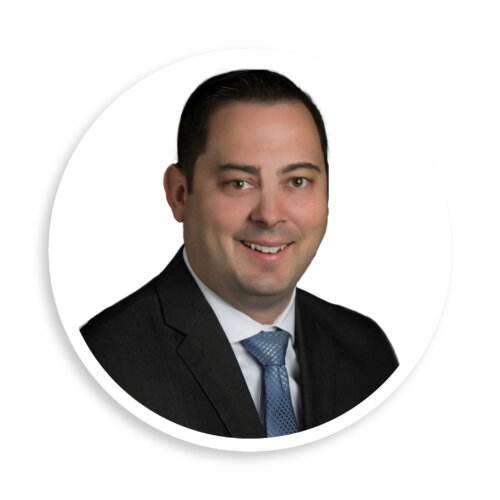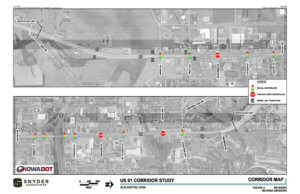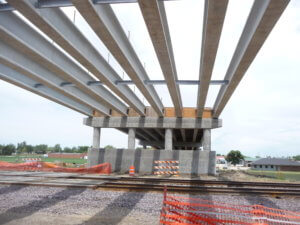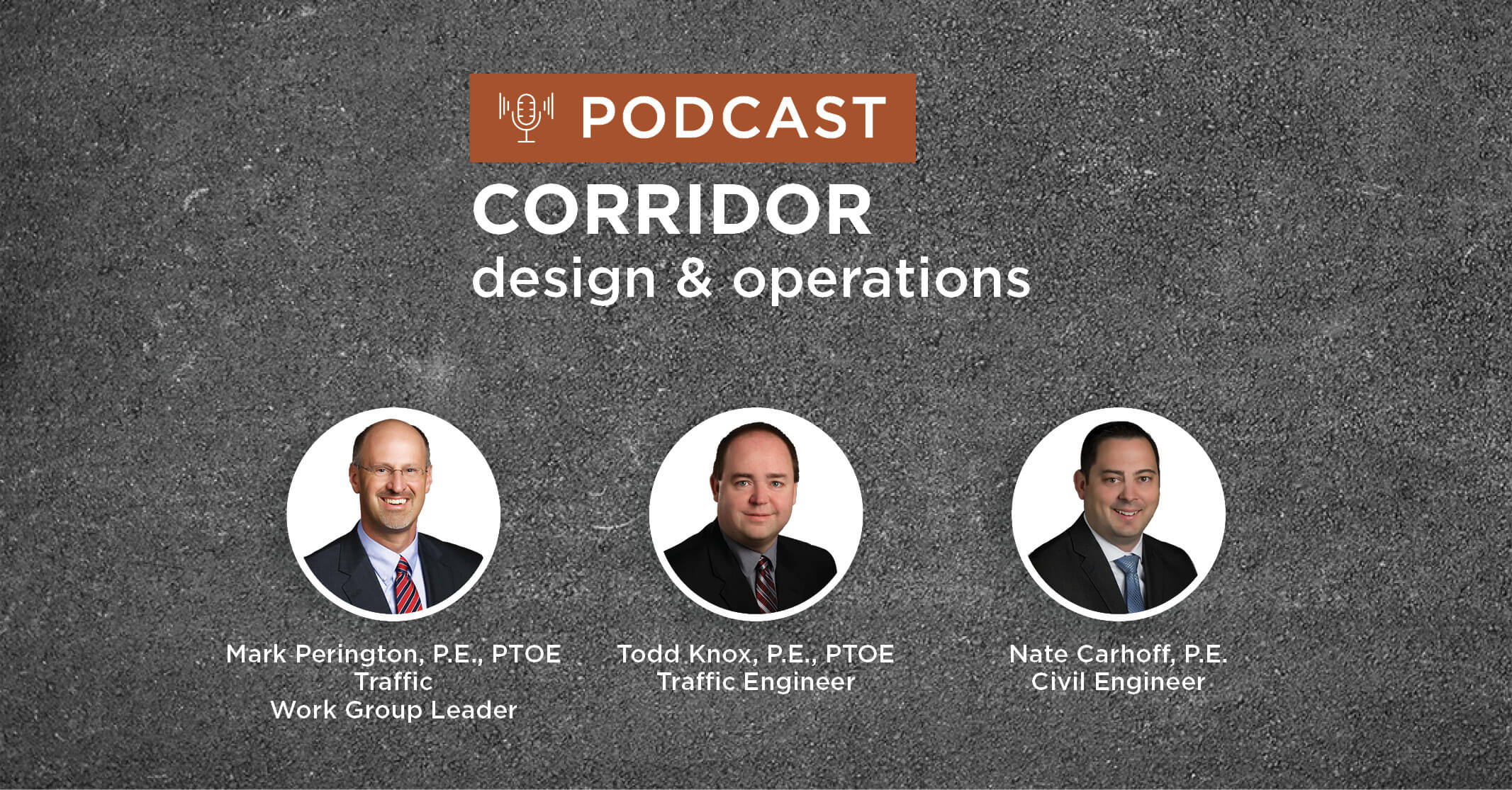Ensuring Safety While Optimizing Corridors
To connect people with their destinations, every community must have safe and effective roadway corridors. Whether it involves planning a new roadway or improving an existing one, the first step is to conduct a thorough inventory of the current infrastructure. Our transportation planners and engineers carefully study important aspects such as traffic patterns and adjacent land use to understand better the challenges faced in a particular area. This information is crucial in determining the best treatment options for a roadway. To learn more about the priorities of our traffic engineering experts when designing and improving corridors, listen to Mark Perington, P.E., PTOE, Todd Knox, P.E., PTOE, and Nate Carhoff, P.E. as they discuss safety and efficiency factors.
Podcast Agenda
- Identifying & Evaluating Corridor Deficiences (0:18)
- Featured Corridor Safety Improvement Projects (3:17)
- Safety & Operational Effects of Geometric Road Design Features (4:41)
- Considerations to Mitigate Crash Potential (6:26)
- Alternative Intersection/Interchanges Treatment Options (8:45)
- Safety for Different Modes of Traffic (12:32)
- Infrastructure Prioritization & Budgeting (18:22)

Mark Perington, P.E., PTOE
Traffic Group LeaderMark Perington, P.E., PTOE
Traffic Group LeaderTransportation planning, Traffic studies, Traffic impact studies, Conceptual intersection, Roadway design

Todd Knox, P.E., PTOE
Traffic EngineerTodd Knox, P.E., PTOE
Traffic EngineerCrash and traffic analyses, traffic signal system review, concept design, and operation timing

Nathan Carhoff, P.E.
Civil EngineerNathan Carhoff, P.E.
Civil EngineerHighway and Street Design, Transportation Planning, Municipal Engineering, Funding Procurement, Trail Design, Pavement Management
Identifying & Evaluating Corridor Deficiencies
Mark Perington (00:18)
Hello, I’d like to welcome everybody listening to this podcast. This is Mark Perington with Snyder and Associates. I’m a Senior Traffic Engineer. I have with me Todd Knox, a Traffic Engineer, who works on a lot of corridor elements, traffic control, and systems. Nate Carhoff, Transportation Engineer, works on a lot of road design, everything from local collector roads and streets to interstate highways. I’ve got a diverse group of people here to have a discussion about what we do in examining safety and the considerations we make in corridor design. We try to correct and mitigate safety problems that we find in the field.
I’m going to open this up with some input on how everything varies and fluctuates when we’re dealing with the type of roadway we have and the land use that may be serving. There are a lot of ways we look at safety and a lot of issues out there. Could you comment on that a little bit, perhaps? Todd, could you expand on some things that you see in these different kinds of corridors?
Todd Knox (1:19)
Sure, Mark. Some of the things that I tend to see expanding beyond the land uses are if we have too many driveways, we have people coming in and out of them, slowing down, stopping, blocking traffic, that kind of creates those rear-end crashes that you see all the time; then parking and somebody opens a door on you as you’re driving by and now you take out a door. Narrow lanes in an area where they might have tried to squeeze a four-lane roadway into basically a three-lane width corridor. Those are some of the things that I tend to see when we’re looking at crash concerns along some of these corridors.
Mark Perington (1:53)
Nate, you work on a lot of different design-type projects. As you go into everything from an intersection of a couple of city streets up to an interstate corridor, what types of things are going through your mind, and what do you want to look into as we’re making sure that we consider safety on all of our designs?
Nate Carhoff (2:09)
When it comes to the design side of roadways, it usually boils down to the speed of the road and the anticipated traffic volumes. Those two tie into what we call a clear zone. When we design roadways, we try to first eliminate objects out of the clear zone on a local street that’s generally speaking within 10 feet of the edge of the pavement. Higher speed roadways, you’re looking at 30 to 40 feet outside of that edge of the roadway. So we look at, first, trying to remove those objects that may become impacted if a vehicle does exit the roadway. Second of all, if we can’t eliminate them or move them, we look at protecting those objects with items such as guardrail barriers. Lastly, we could also look at replacing those objects with a breakaway style. For example, a lot of local streets have light poles that are within the clear zone. They are supposed to break away and not do as much damage. We always like to look at intersections as far as removing those turning vehicles from through traffic. The addition of turn lanes could help reduce the slowdown of traffic and rear-end crashes for those turning vehicles.
Featured Corridor Safety Improvement Projects

The corridor planning process begins with crafting a vision, setting goals for the study, and collecting the necessary data.
Mark Perington (3:17)
At Snyder and Associates, we’ve been working on corridor safety studies going clear back to ‘92, if not a little before then, and we’ve done a lot of review over the years dealing with some of the initial four-lane to three-lane conversions here in the State of Iowa and many other types of corridor studies that truly were all about safety. Where there was a high crash rate, and what can we do to change this? Todd, do you have a unique corridor that sticks out in your mind and how we looked at that, and what type of things we’re trying to address?
Safety & Lane Configuration
Todd Knox (3:47)
Yeah, one project that kind of comes to mind for me was in Fort Dodge. We did a project around ten years ago that was a four-lane undivided roadway, no turn lanes, and lots of driveways in an industrial area within the community. We started looking at the crashes, and it’s like, there’s a lot of rear ends. There are a lot of overtaking-type crashes. Just getting traffic into a single lane would help slow down traffic and improve vehicle visibility. Things like that gave the trucks coming through the corridor more opportunity to get out of the through lane or get more area to be able to turn. It eliminated some of the safety concerns by just changing it from a four-lane undivided to putting in a two-way left-turn lane, down the center, and just a single lane in each direction. That kind of project stood out to me as one that impacted safety along the corridor.
Safety & Operational Effects of Geometric Road Design Features
Mark Perington (4:41)
Nate, could you comment a little further on some of the geometry features that are usually on the front of your mind to make sure, when we’re done with it, it’s as safe a corridor as possible?
Nate Carhoff (4:53)
Sure. On the design side, especially in intersections, one of the biggest factors is site distance. Whether it’s a signal-controlled, stop-controlled intersection, or yield-controlled, you want to have adequate site distance on the main road as well as the side road. So, make sure there aren’t obstructions in that site triangle. Say you’re on a side road approaching a major intersection. You’re going to want to make sure the traffic signal poles and fencing don’t obscure the view from vehicles entering that intersection. The same is true on the main road. You want to have the through traffic able to see cars approaching from a side road.
Mark Perington (5:34)
How about turn lanes and intersection layout, Nate? I mean, some further things on that related to what you focus on when you lay those out and create good site angles?
Nate Carhoff (5:45)
Yes, a lot of it has to do with being able to efficiently get into the turn lane. Opening up that turn lane with a proper taper ratio that’ll allow vehicles to exit the through lane into the turn lane at speed and then have proper deceleration distance within that turn lane so that you can exit the through lane at speed into the turn lane, and then begin your deceleration into your turn movement. The length of the turn lane dictates how efficient they are. Also, thinking about if you have a lot of traffic queuing, you not only want to have adequate deceleration distance, but you also want to have enough storage capacity to handle the number of vehicles turning.
Considerations to Mitigate Crash Potential
Mark Perington (6:26)
We hear it talked about, correctable crashes, and the types of crashes, and again, the thing of what we’re focusing on when we look at a corridor. Todd, expand on that a little bit of how we think about things in the system and is a traffic signal or a roundabout is the right solution. We have multiple in a corridor, what do we have to think about and how do we make them work together, to again, help mitigate any crash potential?
Todd Knox (6:50)
Yeah, everybody seems to think traffic signals are the answer to everything, but really, it just changes the manner of collisions. You try to eliminate the broadside crashes. However, you start creating some other types. The major through movement may have to stop, so now you’re creating rear-end crashes. So you’re not eliminating crashes, you’re just changing the pattern of the collisions there.
Also, you were asking about the corridor-type considerations as you start getting multiple signals along a corridor. Now you’re potentially having them stop multiple times. We’ve been trying to work with communities to create coordination timings so traffic doesn’t stop up as much so they can flow smoother through the corridor, and not create the potential for right-angle crashes or rear-end crashes. That impacts the side street and it’s a whole balancing act that we have to do on the operation side.
Mark Perington (7:47)
I think that’s a good comment. Sometimes, people think that we are trying to have everybody go faster when we do some of these things, and that’s not really what we’re trying to achieve necessarily. It’s more of a uniform flow. I would comment that that’s the thing we see a lot is if we can keep traffic moving more uniformly and we don’t have as many unexpected stops, rapid acceleration, and rapid deceleration, which usually leads to a much safer corridor. I think that’s a great point, Todd, that many times, it isn’t just about the delay. We’re trying to get a more efficient flow through a corridor so that we can try to help with safety and not create problems of people trying to drive fast to make up for lost time.
Todd Knox (8:30)
One thing we try to do is time the signal so that if you’re going at or near the speed limit, that’s the flow that we want you to be going from one signal to the next signal. We’re not encouraging people to go five, to 10 miles an hour over the speed limit, because that creates a safety concern.
Alternative Intersection/Interchange Treatment Options
Nate Carhoff (8:45)
A question for the group here, when we’re talking about corridors, especially with multi-lane, maybe higher volume corridors where you have a side road that has an at-grade crossing. Could one of you speak to the non-traditional intersections, like a J turn? Where the vehicle on the side road isn’t permitted to turn left, they have to turn right, which is a safer movement. Then make a U-turn down the road. Have you guys had experience with those?
Mark Perington (9:14)
Yeah. I know that a lot of treatments we’re looking at deal with the four-lane or six-lane expressway style roadways that we see leading into metropolitan areas, or they can just be some of those four-lane divided that are out in a more rural setting. As Todd was alluding to earlier, sometimes a traffic signal out on a corridor like that that is designed for a higher degree of mobility over a greater distance or higher volume of traffic flow isn’t the best answer for when you have a little bit of interference. Granted, trying to take that right-angle collision away. Sometimes, introducing that red light on a high-speed road means that somebody’s going to stop at some point in time.
That can be a difficult thing. We’re evolving here, I think, in the Midwest, where we’re starting to see more of these types of treatments, such as the R-CUT, as you mentioned. Essentially you’re on the side road, you’re turning right, which is a simplified movement. You’re then making a U-turn, which again, we simplify that for you and give you fewer things to try to take in and deal with, and then re-enter the traffic stream. The goal is that we might be taking somebody about a thousand, 2000 feet out of their way, but the idea is if that one time, we can eliminate that crossing attempt where someone makes a mistake and is not double-checking for traffic in a certain direction. If we can take that away to where that can’t happen, we could be potentially getting rid of a fatality at an intersection with a high-speed, broadside crash.
If there’s one fatality removed out of an intersection, that allows a family member, a friend, whoever it is, to go back home to those people that are important to them. We think that’s a very, very important thing. So again, our approach is mitigating problems and eliminating these potential conflicts, which in turn tend to lead to severe crashes, injuries, and fatalities. I think that’s one of our big goals as designers is how do we do some of those things to get rid of those bad crashes. Todd, If we are seeing certain right angles or a lot of rear-end crashes, what might be things we’re looking for, and how do we impact those? If you guys want to comment with maybe some more specifics as examples?
Todd Knox (11:29)
It’s not just for left-turn lanes, either. We’ve been starting to do a little bit more positive offset or right turn lanes, too, for just the traffic coming out of a driveway or public street. We’ve been shifting the right turn lanes out so that those people either turning right, turning left, or going through can see around that vehicle slowing down to turn right. There are those left-turn lanes, but also, with signal control, we can do some things that can help mitigate some of these turning movements. We’ve seen the flashing yellow arrow pop up more and more, and it is getting to be pretty widespread across the state. That gives us the flexibility to if we see by the time of day that a left turn crash they can’t see around the vehicle opposing them. We can implement a protected-only left-turn movement for just those few hours that we deem necessary. Then we can go back and release it to a right now, which will allow the protected left to go, but we’ll also follow it up with a permissive movement. There are a few things like that that we can do with the traffic signal.
Safety for Different Modes of Traffic
Mark Perington (12:32)
Nate, as we look at some of these corridors, we are serving a lot of different modes of traffic. It isn’t always just a low-speed street that may have pedestrians and bicyclists out there as well. We use these corridors to create a movement for them as well, whether they’re recreational

Construction of a four-lane, eight-span, 1,100-foot-long roadway overpass to carry vehicle and pedestrian traffic over the railroad tracks.
activities or commuting routes. Maybe comment on geometry as you look at those, what has to go through your mind as you approach intersections within the corridor, or just any other design elements where you’re sharing these different types of modes of traffic?
Nate Carhoff (13:01)
Most times, we want to keep that far away from the through traffic movement, just for safety purposes. We want to keep pedestrians out of the clear zone as well. So a lot of times, in a four-lane facility, the sidewalk or the trail will be located at the edge of the right-of-way or as far away from the vehicle travel way as possible. Like you mentioned at intersections though, we want to make sure that those crossings are as visible as possible and create as safe a crossing as we can. Some things to consider at the intersection are the location of the crossing and adding refuge islands in between the opposing traffic that provide you some sort of barrier so you can cross safely.
Sometimes, the location at an intersection may not be best. We’ve seen some places where a mid-block crossing may work better, typically on lower-speed roadways. Those can be made safer by the addition of raised pedestrian crossings, proper signing, or even pedestrian signals. There are specific situations where that could be advantageous for safety versus locating them at an intersection. Of course, where applicable, we’d also look at a grade-separated facility where vehicles can cross a major roadway, either going underneath that in a tunnel or up over the top in a bridge, just to eliminate that conflict. That is, of course, the safest option when it comes to pedestrian crossings.
Mark Perington (14:35)
Right, the vulnerability of bicyclists and pedestrians is key. We know from the pure physics of the outcomes when you have a conflict between these different modes, car, truck, versus, say, bike, ped, and that’s something I think we all are very focused on when we deal with these corridors and what we examine. I think the other side to it is these corridor studies, and looking at safety within a corridor, sometimes it’s stepping back farther and looking at the intersection in its entirety that we see more trends. There might be this concern, this complaint, but if you get too zoomed in on it, you may not notice what may be happening as far as severity with crashes and other issues of things we can correct.
We try to make sure that safety is an element of anything we’re doing, even when it’s as simple as we’re adding a turn lane or something. If we’ve taken a really good look at it to see, is there anything, while we’re touching this area in a corridor at an intersection, that we can make better while that investment is being made? Because we’ve certainly emphasized in a lot of our other discussions that budgets are so limited. You hate to do more of a maintenance project and then realize a little later that if we would’ve looked at safety a little more, there are a few things we would’ve done while the contractor was out there doing the work and in the incremental budget of the whole thing. It could have been a very small difference to make a correction out there to, again, try to have a positive impact on the crash frequency or mitigate things that are up and out there, reducing severity.
Nate Carhoff (16:07)
It could be as little as four feet that allows those bicyclists that are out in the more rural areas who are going to right on the road to give them a little bit of a shoulder to take them out of the through traffic, as much as possible. It could make a world of difference and at a very minimal incremental cost increase.
Mark Perington (16:29)
That little bit of extra pavement out there can end up having a lot of incremental differences in safety over time. Todd, did you have something you wanted to mention?
Todd Knox (16:40)
Yeah, these safety improvements that we’ve been discussing, some of them are not cheap. Yet, here in Iowa, we do have Transportation Safety Improvement Program Funding that does provide opportunities for agencies to obtain funding through the DOT to pay for some of these improvements. We’d like to address these safety problems as much as we can, and this just provides a funding mechanism for that.
Nate Carhoff (17:06)
Guardrail isn’t a bad thing to have. Sometimes, we, as designers, look at protecting stuff within the clear zone or try to eliminate objects out of the clear zone. If we can’t do that, we have to do that with a guardrail or some other sort of barrier. Sometimes, it’s not necessarily in the clear zone that we’re trying to make safer. For example, on the interstate, the new standard for median width would lead a designer to believe that if a vehicle leaves the roadway towards the median side, there should be ample distance there to recover before creating a head-on collision on the interstate. We want to weigh the benefit versus the cost of what would happen if someone does leave the roadway. There have been such where there is ample median space. Yet, we still put the cable guardrail up because the worst thing that could happen is someone still does cross through the median and into a head-on collision at high speed. If you leave the roadway and you hit the guardrail, that prevents you from crossing the center line and, most likely, a fatal crash head-on.
Infrastructure Prioritization & Budgeting
Mark Perington (18:22)
Going back to the point for agencies of limited budgets, we don’t have unlimited resources to try to design everything. Many times we have to do these proven methods that tend to show a lower cost to implement but have a large benefit. The cable barrier rail that you’re referring to on Interstates is a great example of a fairly low-maintenance item that they have to deal with.
Did it potentially save that vehicle, though, from your point of crossing across the median? People with some body damage to vehicles is far less than if we have one or two cars go across the median and end up in a head-on collision. That can end up resulting in fatalities, a lot of severe injuries, and just a very tragic thing. I think that’s what we’re looking for in the safety in these corridors is techniques and measures that, again, may have a different side consequence to it, but we help take away the severity of crashes, injuries, and fatalities. These are things that we’re trying to look at these days and that can be applied at all levels of roadways and features we do with the infrastructure.
At the end of the day, though, safety is such an important element of what we consider, and it has to be. We hope through the processes and the approaches we take, we do our best to help agencies deliver and improve roadway networks and make things as safe as possible for the traveling public. So thank you.
